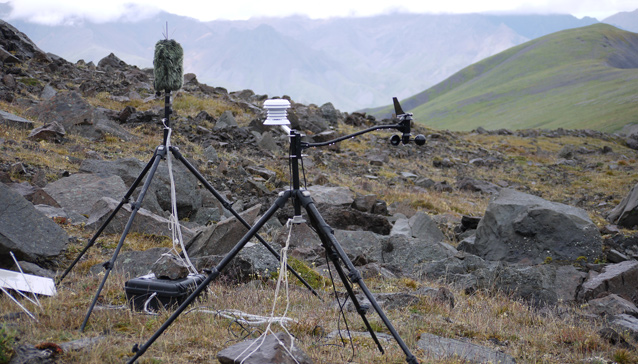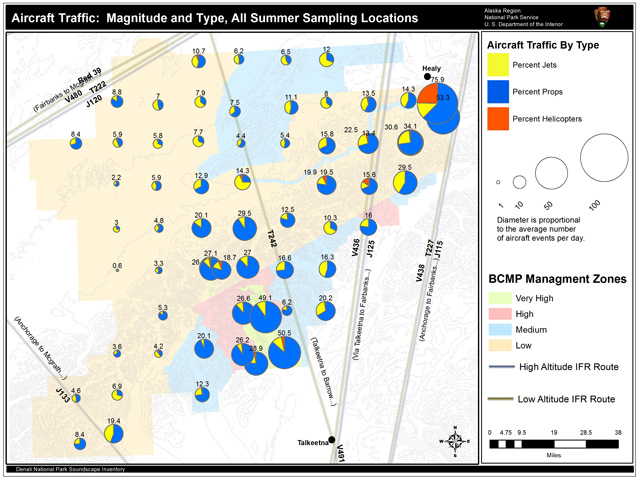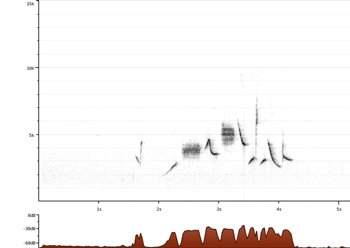
NPS Photo
Soundscape research has been underway at Denali since 2001. Natural and human-generated sounds are being systematically inventoried across the entire landscape of the park, including popular backpacking areas, Mt. McKinley climbing routes, and along the park road. From digital recordings and sound levels that have been documented, park staff can calculate the percentage of time and the number of times per day that sounds are audible as well as the calibrated sound level (loudness) of important events. The sound-level data are used to compare the levels of human-made sounds to the natural ambient levels. Sound data are also converted into a visual representation - or spectrogram - from which a trained technician can identify aircraft overflights. Each aircraft is categorized by propulsion type (propeller plane, jet plane, or helicopter) for further understanding of daily traffic patterns.
Monitoring in 2014:
Soundscape staff implemented the seventh season of a revised systematic sampling plan in 2015, deploying seven automated sound monitoring stations and rotating them among 10 locations. These locations were: two winter-season sites, 6 Central Alaska Network (CAKN) Inventory & Monitoring grid points, 1 location to monitor commercial use on the Ruth Glacier, and 1 location to understand use at the McKinley National Park Airport. Over the ten-year period from 2006 through 2015, stations are scheduled to be placed at six new locations each year—each randomly selected from a 10x10 Km grid of 60 points spread evenly throughout the park. As the inventory comes to completion in 2015, a greater amount of work has been conducted on special projects – such as the focused study of specific noise sources within Denali, specific areas of interest, or assisting other parks in the Alaska region with soundscape issues. In 2014, eight sites were sampled outside of Denali: two in Noatak National Preserve to monitor aircraft use during the sport hunting season, and six in Gates of the Arctic National Park and Preserve to collect baseline data in response to the State of Alaska’s proposed construction of an industrial road to the community of Ambler, AK – a portion of which would be routed through the preserve.
From the acoustic data processed since 2006, Denali’s natural soundscape is primarily characterized by the energy of wind and water – and at certain times or locations, the striking absence of that energy. In fact, the natural ambient level is usually logarithmically related to wind speed. The quietest level (when not limited by the instrumentation, itself,) is typically governed by the distance from nearby water sources and their power. Overlain upon these steady physical sounds are seasonal or daily cycles affected by sunlight or temperature. For instance, insect flight, bird song, and debris flows down steep-walled valleys all follow a unique but predictable daily pattern of occurrence related to light energy.
Human caused noise also follows a definite spatial-temporal pattern. At locations near common flightseeing routes, traffic rates commonly exceed 30 overflights per day. At landing strips, it is common to hear more than one-hundred. On the other hand, locations father away from common flightseeing routes rarely exceed ten overflights per day. This variation in traffic becomes clearer when visualized spatially. The following map shows a pie-chart breakdown of traffic by aircraft type for every site sampled in the inventory to date. The radius of the pie-chart circle is proportional to the average number of aircraft overflights per day.


In 2014, selections of bird song and calls were compiled from longer soundscape recordings to contribute to Xeno-Canto, a worldwide collaborative bioacoustics project. As described on the project’s website, “Xeno-canto uses the evolving possibilities of the internet to: popularize bird sound recording worldwide, improve accessibility of bird sounds, & increase knowledge of bird sounds... Recordings are here for: enjoyment, education, conservation, & science.”
175 recordings from 51 locations across Denali and the state of Alaska have been contributed to the project so far. These represent 54 species of birds, most of which are the northern-most example of the species on Xeno-Canto. Of these 31 were added as new species in 2014. Acoustic monitoring across a range of habitats has benefitted the detection of species rarely-recorded in North America - such as the Golden Eagle (Aquila chrysaetos), Great Grey Owl (Strix nebulosa), Wandering Tattler (Tringa incana), Long-tailed Jaeger (Stercorarius longicaudus), Whimbrel (Numenius phaeopus), and American Golden-plover (Pluvialis dominica).
Denali is continuing to develop the usefulness of sound stations in monitoring avian population, especially for estimates of occupancy, species richness or phenological timing. Because soundscape data have a large spatial extent, they can help extend management knowledge from traditional passerine surveys to greater areas of the park.
Upcoming work:
In 2015, the Denali soundscape inventory will be concluded by finishing the six remaining Inventory & Monitoring grid points. In addition, information will be collected at several of the portal airstrips to inform management about current aviation uses of the park. Detailed soundscape reports can be found on the NPS Integrated Resource Management Applications (IRMA) website by searching for “Betchkal OR Withers”. A quick and easy-to-use interactive data map complete with a selection of audio clips can be found on the park website.
Last updated: February 11, 2016
